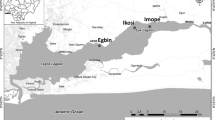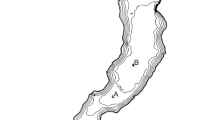Abstract
The objective of this study was to determine if extreme acidic Lake Caviahue could be used as a sentinel of atmospheric deposition hypothesizing that the physiological state of algae will be the indicator parameter. The lake was sampled from 2000 to 2015 in order to determine chlorophyll concentration, algae abundance and phytoplankton in vivo fluorescence as a way to evaluate the physiological state of algae. Development and physiological state of phytoplankton in different seasons was related to concentration and dynamics of nutrients in the lake. Laboratory experiments of Keratococcus rhaphidiodes to nitrogen (N) enrichment confirmed that an increase in nutrient content enabled a better physiological state of algae (e.g. higher chlorophyll per cell). Therefore, under the projected scenarios of climate change, the increase of available N through the increase in deposition and the increase of dissolved inorganic carbon, as consequence of higher atmospheric CO2, will compensate the natural nutrient constraints observed in the phytoplankton of the lake. The effect that the atmospheric CO2 has on the DIC, and this on algal development, as well as the influence that N has on algal growth, make Lake Caviahue an interesting sentinel of nutrient deposition at regional level.








Similar content being viewed by others
References
Adrian, R., C. O’Reilly, H. Zagarese, S. Baines, D. Hessen, W. Keller, D. Livingstone, R. Sommaruga, D. Straile, E. Van Donk, G. Weyhenmeyer & M. Winder, 2009. Lakes as sentinels of climate change. Limnology and Oceanography 54: 2283–2297.
APHA, 1992. Standard Methods for the Examination of Water and Wastewater. American Public Health Association, Washington.
Baffico, G., 2013. Optical properties and light penetration in a deep, naturally acidic, iron rich lake: Lago Caviahue (Patagonia, Argentina). Limnologica 43: 475–481.
Baffico, G., M. Diaz, M. Wenzel, M. Koschorreck, M. Schimmele, T. Neu & F. Pedrozo, 2004. Community structure and photosynthetic activity of epilithon from a highly acidic (pH ≤ 2) mountain stream in Patagonia, Argentina. Extremophiles 8: 463–473.
Beamud, S., M. Diaz & F. Pedrozo, 2007. Summer phytoplankton composition and nitrogen limitation of the deep, naturally-acidic (pH ~ 2.2) Lake Caviahue, Patagonia, Argentina. Limnologica 37: 37–48.
Beamud, G., M. Diaz, N. Baccalá & F. Pedrozo, 2010a. Analysis of patterns of vertical and temporal distribution of phytoplankton using statistical tools: lake Caviahue, Patagonia, Argentina. Limnologica 40: 140–147.
Beamud, S., M. Diaz & F. Pedrozo, 2010b. Nutrient limitation of phytoplankton in a naturally acidic lake (Lake Caviahue, Argentina). Limnology 11: 103–113.
Bock, E., H. P. Koops & H. Harms, 1986. Cell Biology of Nitrifying Bacteria. In Prosser, J. I. (ed.), Nitrification. IRL Press, Society for General Microbiology, Oxford: 17–38.
Camacho, A. & E. Fernández-Valiente, 2005. Un mundo dominado por los microorganismos. Ecología microbiana de los lagos antárticos. Ecosistemas 14: 66–78.
Christensen, M., M. Graham, R. Vinebrooke, D. Findlay, M. Paterson & M. Turner, 2006. Multiple anthropogenic stressors cause ecological surprises in boreal lakes. Global Change Biology 12: 2316–2322.
Civerolo, K., C. Hogrefe, B. Lynn, C. Rosenzweig, R. Goldberg, J. Rosenthal, K. Knowlton & P. Kinney, 2008. Simulated effects of climate change on summertime nitrogen deposition in the eastern US. Atmospheric Environment 42: 2074–2082.
Cleveland, J. & M. Perry, 1987. Quantum yield, relative specific absorption and fluorescence in nitrogen-limited Chaetoceros gracilis. Marine Biology 94: 489–497.
Daufresne, M., K. Lengfellner & U. Sommer, 2009. Global warming benefits the small in aquatic ecosystems. Proceedings of the National Academy of Sciences of the United States of America 106: 12788–12793.
Dentener, F., J. Drevet, J. Lamarque, I. Bey, B. Eickhout, A. Fiore, D. Hauglustaine, L. Horowitz, M. Krol, U. Kulshrestha, M. Lawrence, C. Galy-Lacaux, S. Rast, D. Shindell, D. Stevenson, T. Van Noije, C. Atherton, N. Bell, D. Bergman, T. Butler, J. Cofala, B. Collins, R. Doherty, K. Ellingsen, J. Galloway, M. Gauss, V. Montanaro, J. Müller, G. Pitari, J. Rodriguez, M. Sanderson, F. Solmon, S. Strahan, M. Schultz, K. Sudo, S. Szopa & O. Wild, 2006. Nitrogen and sulfur deposition on regional and global scales: A multimodel evaluation. Global Biogeochemical Cycles 20: GB4003.
Field, C. B., V. R. Barros, K. J. Mach, M. D. Mastrandrea, M. van Aalst, W. N. Adger, D. J. Arent, J. Barnett, R. Betts, T. E. Bilir, J. Birkmann, J. Carmin, D. D. Chadee, A. J. Challinor, M. Chatterjee, W. Cramer, D. J. Davidson, Y. O. Estrada, J.-P. Gattuso, Y. Hijioka, O. Hoegh-Guldberg, H. Q. Huang, G. E. Insarov, R. N. Jones, R. S. Kovats, P. Romero-Lankao, J. N. Larsen, I. J. Losada, J. A. Marengo, R. F. McLean, L. O. Mearns, R. Mechler, J. F. Morton, I. Niang, T. Oki, J. M. Olwoch, M. Opondo, E. S. Poloczanska, H.-O. Pörtner, M. H. Redsteer, A. Reisinger, A. Revi, D. N. Schmidt, M. R. Shaw, W. Solecki, D. A. Stone, J. M. R. Stone, K. M. Strzepek, A. G. Suarez, P. Tschakert, R. Valentini, S. Vicuña, A. Villamizar, K. E. Vincent, R. Warren, L. L. White, T. J. Wilbanks, P. P. Wong & G. W. Yohe, 2014. Technical summary. In C. B. Field, V. R. Barros, D. J. Dokken, K. J. Mach, M. D. Mastrandrea, T. E. Bilir, M. Chatterjee, K. L. Ebi, Y. O. Estrada, R. C. Genova, B. Girma, E. S. Kissel, A. N. Levy, S. MacCracken, P. R. Mastrandrea & L. L. White (eds), Climate Change 2014: Impacts, Adaptation, and Vulnerability. Part A: Global and Sectoral Aspects. Contribution of Working Group II to the Fifth Assessment Report of the Intergovernmental Panel on Climate Change. Cambridge University Press, Cambridge: 35–94.
Gammons, C., S. Wood, F. Pedrozo, J. Varekamp, B. Nelson, C. Shope & G. Baffico, 2005. Hydrogeochemistry and rare earth element behavior in a volcanically acidified watershed in Patagonia, Argentina. Chemical Geology 222: 249–267.
Geider, R., 1987. Light and temperature dependence of the carbon to chlorophyll a ratio in microalgae and cyanobacteria: implications for physiology and growth of phytoplankton. New Phytologist 106: 1–34.
Gruber, N. & J. Galloway, 2008. An earth-system perspective of the global nitrogen cycle. Nature 451: 293–296.
Heaney, S., 1978. Some observations on the use of the in vivo fluorescence technique to determine chlorophyll-a in natural populations and cultures of freshwater phytoplankton. Freshwater Biology 8: 115–126.
Hessen, D., T. Andersen, S. Larsen, B. Skjelkvåle & H. de Wit, 2009. Nitrogen deposition, catchment productivity, and climate as determinants of lake stoichiometry. Limnology and Oceanography 54: 2520–2528.
Hill, G. J. C. & L. Machlis, 1970. Defined media for growth and gamete production by the green alga Oedogonium cardiacum. Plant Physiology 46: 224–226.
Hillebrand, H., C.-D. Dürselen, D. Kirschtel, U. Pollingher & T. Zohary, 1999. Biovolume calculation for pelagic and benthic microalgae. Journal of Phycology 35: 403–424.
Huertas, I., M. Rouco, V. López-Rodas & E. Costas, 2011. Warming will affect phytoplankton differently: evidence through a mechanistic approach. Proceedings of the Royal Society B. doi:10.1098/rspb.2011.0160.
IPCC, 2013a. Annex I: Atlas of Global and Regional Climate Projections [G. J. van Oldenborgh, M. Collins, J. Arblaster, J. H. Christensen, J. Marotzke, S. B. Power, M. Rummukainen and T. Zhou (eds.)]. In T. F. Stocker, D. Qin, G.-K. Plattner, M. Tignor, S. K. Allen, J. Boschung, A. Nauels, Y. Xia, V. Bex and P. M. Midgley (eds), Climate Change 2013: The Physical Science Basis. Contribution of Working Group I to the Fifth Assessment Report of the Intergovernmental Panel on Climate Change. Cambridge University Press, Cambridge.
IPCC, 2013b. Annex II: Climate System Scenario Tables [M. Prather, G. Flato, P. Friedlingstein, C. Jones, J.-F. Lamarque, H. Liao and P. Rasch (eds)]. In T. F. Stocker, D. Qin, G.-K. Plattner, M. Tignor, S. K. Allen, J. Boschung, A. Nauels, Y. Xia, V. Bex and P. M. Midgley (eds), Climate Change 2013: The Physical Science Basis. Contribution of Working Group I to the Fifth Assessment Report of the Intergovernmental Panel on Climate Change. Cambridge University Press, Cambridge.
Juergens, M., R. Deshpande, B. Lucker, J.-J. Park, H. Wang, M. Gargouri, F. Holguin, B. Disbrow, T. Schaub, J. Skepper, D. Kramer, D. Gang, L. Hicks & Y. Shachar-Hill, 2015. The regulation of photosynthetic structure and function during nitrogen deprivation in Chlamydomonas reinhardtii. Plant Physiology 167: 558–573.
Kiefer, D., 1973. Chlorophyll a fluorescence in marine centric diatoms: responses of chloroplasts to light and nutrient stress. Marine Biology 23: 39–46.
Livingstone, D. & M. Dokulil, 2001. Eighty years of spatially coherent Austrian lake surface temperatures and their relationship to regional air temperature and the North Atlantic Oscillation. Limnology and Oceanography 46: 1220–1227.
Mackereth, F., J. Heron & J. Talling, 1978. Water analysis: Some revised methods for limnologists. Scientific Publication No 36. Freshwater Biological Association, Ambleside.
Montagnes, D., J. Berges, P. Harrison & F. Taylor, 1994. Estimating carbon, nitrogen, protein, and chlorophyll a from volume in marine phytoplankton. Limnology and Oceanography 39: 1044–1060.
Montgomery, D., 2005. Design and analysis of experiments, 5th ed. Wiley & Sons, New York.
Morán, X., Á. López-Urrutia, A. Calvo-Díaz & W. Li, 2010. Increasing importance of small phytoplankton in a warmer ocean. Global Change Biology 16: 1137–1144.
Pedrozo, F., S. Chillrud, P. Temporetti & M. Diaz, 1993. Chemical composition and nutrient limitation in rivers and lakes of northern Patagonian Andes (35.5°–42°S, 71°W) (Rep. Argentina). Verhandlungen der Internationale Vereinigung für Theoretische und Angewandte Limnologie 25: 207–214.
Pedrozo, F., L. Kelly, M. Diaz, P. Temporetti, G. Baffico, R. Kringel, K. Friese, M. Mages, W. Geller & S. Woelfl, 2001. First results on the water chemistry, algae and trophic status of an Andean acidic lake system of volcanic origin in Patagonia (Lake Caviahue). Hydrobiologia 452: 129–137.
Pedrozo, F., P. Temporetti, G. Beamud & M. Diaz, 2008. Volcanic nutrient inputs and trophic state of Lake Caviahue, Patagonia, Argentina. Journal of Volcanology and Geothermal Research 178: 205–212.
Satake, K. & Y. Saijo, 1974. Carbon dioxide content and metabolic activity of microorganisms in some acid lakes in Japan. Limnology and Oceanography 19: 331–338.
Sauer, J., U. Schreiber, R. Schmid, U. Völker & K. Forchhammer, 2001. Nitrogen starvation-induced chlorosis in Synechococcus PCC 7942. Low-level photosynthesis as a mechanism of long-term survival. Plant Physiology 126: 233–243.
Schindler, D., 2009. Lakes as sentinels and integrators for the effects of climate change on watersheds, airsheds, and landscapes. Limnology and Oceanography 54: 2349–2358.
Seebens, H., D. Straile, R. Hoegg, H. Stich & U. Einsle, 2007. Population dynamics of a freshwater calanoid copepod: complex responses to changes in trophic status and climate variability. Limnology and Oceanography 52: 2364–2372.
Utermöhl, H., 1958. Zur Vervollkommnung der quantitativen Phytoplankton-Methodik. Mitteilungen Internationale Vereinigung für Theoretische und Angewandte Limnologie 9: 1–38.
Vandonk, E., D. Hessen, A. Verschoor & R. Gulati, 2008. Re-oligotrophication by phosphorus reduction and effects on seston quality in lakes. Limnologica 38: 189–202.
Varekamp, J., 2008. The volcanic acidification of glacial Lake Caviahue, Province of Neuquen, Argentina. Journal of Volcanology and Geothermal Research 178: 184–196.
Williamson, C., J. Saros, W. Vincent & J. Smol, 2009. Lakes and reservoirs as sentinels, integrators, and regulators of climate change. Limnology and Oceanography 54: 2273–2282.
Wynn-Williams, D., 1996. Antarctic microbial diversity: the basis of polar ecosystem processes. Biodiversity and Conservation 5: 1271–1293.
Acknowledgements
The authors wish to thank Pepe di Giusto for field help and three anonymous reviewers for helping to improve the manuscript. This study was funded by grants from Agencia Nacional de Promoción Científica y Tecnológica (PICT 2012/1389), Consejo Nacional de Investigaciones Científicas y Tecnológicas (PIP 11220090100013) and Universidad Nacional del Comahue (Prog. B04/166).
Author information
Authors and Affiliations
Corresponding author
Additional information
Guest editors: Beatriz E. Modenutti & Esteban G. Balseiro / Andean Patagonian Lakes as Sensor of Global Change
Rights and permissions
About this article
Cite this article
Baffico, G., Diaz, M., Beamud, G. et al. Lake Caviahue: an extreme environment as a potential sentinel for nutrient deposition in Patagonia. Hydrobiologia 816, 49–60 (2018). https://doi.org/10.1007/s10750-017-3281-5
Received:
Revised:
Accepted:
Published:
Issue Date:
DOI: https://doi.org/10.1007/s10750-017-3281-5




